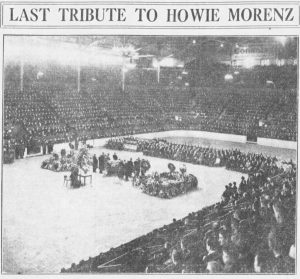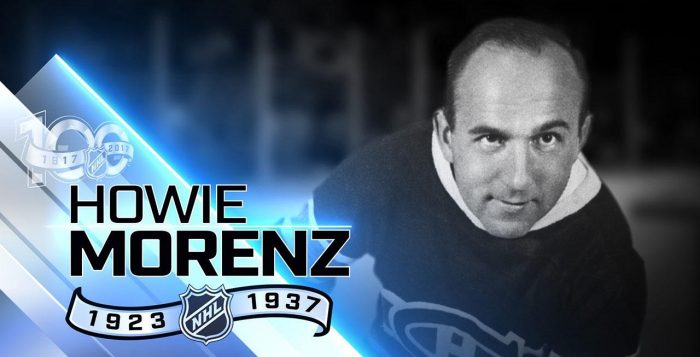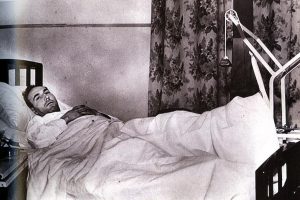This Day in Hockey History – March 8, 1937 – Howie Morenz’s Passing
If hockey had royalty, then certainly Howie Morenz would be among them. In many ways he was the first true superstar of the National Hockey League and while he had other nicknames, he was often referred to as the “Babe Ruth of hockey.”
Morenz’s career had come to an uncomfortable end when, on January 28, 1937, he shattered his left leg during a game against the Chicago Black Hawks at the Montreal Forum. He had tripped along the boards and found himself on the ice under Chicago’s defenseman Earl Seibert, who had finished a check on him. After being taken to St. Luke’s Hospital it was discovered that his leg was fractured in four places. He was still in the hospital when, on March 8, 1937, he died of a coronary embolism (blood clot).
Sadly, the doctor had diagnosed the clots in Morenz’s leg that morning and Morenz was scheduled for surgery to be performed on March 9, but that would turn out be too late. Blood clots are a serious issue and doctors now understand that they can travel from the legs to the arteries between the heart and the lungs and are often fatal.
Over the years many stories arose that he died of a broken heart when it became clear he would never play hockey again or that he had committed suicide, but none of those things were true.
However, his death stunned the hockey community. Many would feel the loss of this player throughout the NHL. And for the Black Hawks Seibert, he took his guilt to his own grave in 1990, despite having nothing to be guilty of. His hit had been perfectly clean, something that Morenz had stated in the hospital. The damage to Morenz’s leg was the result of his skate getting caught in a rut just before Seibert’s hit.
“Play against him? I killed him,” Seibert told a reporter one time who asked if he had squared off against Morenz.
And though Morenz had insisted it wasn’t Seibert’s fault, the defenseman would be booed for years afterward by the Montreal fans.
The Gazette on Tuesday, March 9, announced the death of Morenz on the front page—“Howie Morenz Canadien Star, Dies Suddenly.”
“Howie Morenz, famous Canadien Hockey Club star, numbered among the all-time hockey greats, died suddenly in St. Luke’s Hospital about 11:30 o’clock last night, victim of a heart attack. Morenz, who returned this season to the club with which he broke into the National Hockey League in 1923-24 after a two-year absence, was again climbing to his former heights of brilliance when a fractured leg cut short his sensational comeback on January 28 last. He had been in hospital ever since.”
Further coverage elsewhere in that issue included quotes from many of the NHL’s leaders at the time.
“I can’t believe it… It’s an upsetting thing. And it is certainly hard for an athlete of Howie’s type to go so quickly. It is a terrible loss to the game and a terrible loss to Canadiens themselves. I certainly feel sorry for his family, for Howie thought a lot of his young boy, who surely will miss him,” said Conn Smythe, general manager of the Toronto Maple Leafs.
“This is a terrible loss to organized hockey. Myself and everybody in hockey is going to feel a deep sense of personal loss at Howie’s death. He was one of the all time greats of the game and it was only for the good of that game that the Rangers let him return to the Canadiens he loved so well. I knew he was in bad shape but his death comes as a great shock,” shared Lester Patrick, general manager of the New York Rangers.

Howie Morenz’s Funeral at the Forum (Photo:
Newspapers.com)
Morenz’s funeral, which was held three days later on March 11, would actually take place at the Montreal Forum, with his casket lying in state on the ice.
“’Peace hath her victories no less renowned than war.’ It follows that peace also has her heroes. Ten thousand men and women and small boys paid homage to one of them yesterday afternoon when they thronged into the Forum to take part in the funeral of Howie Morenz. The ice he used to skate over was covered with grey boards. The centre where he played so brilliantly as to bring the crowds out of their seats with cheers was heaped with flowers—so strange in a hockey arena—and he lay there, still, in his coffin. At his head and at his feet stood his friends and admirers. All around the rink, tier on tier, to the very rafters, were gathered the fans, strangely quiet,” described The Gazette of his funeral.
The service was even broadcast over the radio and the road the cortege took to the cemetery was lined as well. It was estimated that 25,000 mourners came to honor the fallen hockey great.
So great was his legacy to the sport that he would be one of twelve inducted into the Hockey Hall of Fame in its inaugural year in 1945.
The Mitchell, Ontario native died at the age of 34, having played in the NHL for 13 seasons in which he played 550 games, amassing 271 goals, 201 assists for 472 points in regular season play. He also played 39 Stanley Cup playoff games notching 13 goals and nine assists for 22 points. He won the Hart Memorial Trophy three times in 1928, 1931, and 1932. In many ways his name is synonymous with the Montreal Canadiens.
Additional Sources:
- The Gazette (Montreal, Canada), Tuesday, March 9, 1937, pp. 1, 14.
- The Gazette (Montreal, Quebec), Friday, March 12, 1937, pp. 13, 15.
- Dave Stubbs, “Remembering Howie Morenz, NHL’s first superstar”















